The content of the article
How to care for indoor violets? This question still arises among many lovers of indoor flowers. And although these flowers have long been not uncommon on window sills, it happens that they rarely bloom. They sit for years in pots, the hosts dance around them, but all the buds are gone.
For some reason, it is believed that the senpolia is a rather capricious plant. This is an erroneous opinion. Indoor violet is very unpretentious. For normal growth and good flowering, she needs certain conditions, but they are not sky-high or super-special. It is fully feasible in a city apartment or house in the countryside.
To violets pleased annual flowering, you need to pay attention to:
- lighting
- soil and pot size
- temperature
- watering
- top dressing
- diseases and pests
Classic kit for the care of ordinary plants. Let's figure it out, and in the end we will find out the secret of shock therapy for the rapid release of buds and the onset of flowering at any time of the year.
Lighting
Grow indoor violets on the windowsill, but shade from exposure to direct sunlight. It can be a light light curtain or white paper.
Or even put a flower on a shelf in the back of the room. But then you have to use a fluorescent lamp.
Tip. If the house has a northern window, then indoor violets can be settled there. Only in winter shade them a little. Because the sun, reflected from the snow, can burn the leaves.
Soil and pot size
The plants have very moody roots. Moreover, the entire root system is relatively small. Therefore, for an adult bush, pots or flowerpots with a diameter of not more than 12 cm will be ideal. For young plants, even less.
If you plant a room violet in a hefty pot, then it will begin to grow green mass with special zeal and give a lot of children. But he categorically refuses to bloom. Choose which is more important - a huge bush of burdocks or many beautiful flowers.
The soil should be loose. A good combination is obtained if you mix fertile land, moss (peat) and clean sand. The proportions are 1 to 1 to 1. This is a very breathable mixture, exactly what the roots of violets are so fond of.
At the bottom of the pot for planting, drainage is necessarily poured. From a third to half the volume. This is necessary so that excess moisture drains as much as possible from the tank. Thanks to such a landing, the roots will not begin to rot.
The pot itself may be of any material other than glass. Because the roots of indoor violets must be in the dark. It is advisable to provide the roots with heat, even in the hot season. To do this, put a foam plate, a woolen napkin or a wooden stand under the cache-pot. Thus, the bottom of the plant will be protected from the cold.
Tip. Do not put on fabric such now fashionable fabric or knitted “cup holders”. They absorb excess moisture and dry for a very long time. Despite their beauty, they prevent the access of heat from the outside, so the roots can be cold.
Temperature
The most magnificent, beautiful and long flowering occurs when indoor violets are constantly at the same temperature, 21-23 ° C. These are adult plants. Young people prefer a little higher: 24-25 ° C.
When these values are exceeded, the flowers begin to fade, deform, the leaves curl down to the pot, petioles are shortened. If the air temperature rises above + 35 ° C, indoor violets begin to die. To help them in the hot season, they will surely moisten the air around, or rearrange the flowers in a cooler place.
When the temperature drops below + 19 ° C, the senpolia stops growing, the buds dry out without opening. At + 15 ° C, the roots begin to rot, the plant becomes sick and dies. To save flowers, provide additional heating. Sometimes an incandescent bulb is enough.
Tip. Make sure that there is no sudden drop in temperature or draft near the room violet. This is part of proper care.
Watering
Everything is simple here. Settled water with a temperature slightly above room temperature. Put the pots in a large container and pour this water so that it reaches the outside to half the height. After 20 minutes, the cache-pot is removed and returned to the place.
Watering in pallets is wrong, because half the pot is drainage, and it does not absorb water. You can not bother with dragging indoor violets into a basin and vice versa. Then just very neatly, with a thin stream, watered from above. They try so that the liquid does not get on the leaves and the growth point. If, by negligence, this still happened, then as soon as possible they wet the plant with a napkin. Do not wipe! Namely, they are blotted so as not to damage the villi on the leaves.
Pour water from above so much that it begins to stand out in the pan. After 15 minutes, excess fluid is removed.
Watering is necessary as necessary. How to determine what time it is? Lower the finger into the ground. If moisture is felt, it is still early. If you take out your finger dry, then it's time to drink the violets. The method is dirty, but reliable.
There is one more secret. It is suitable for those with many different varieties. Skip the usual watering time for 2-3 days. There are varieties that, when drought, begin to lower the leaves down. This is clearly visible. Find such a plant in your thickets and navigate through it. Leaves bend - then water all the violets. After all, the conditions of detention are the same for everyone.
Tip. Now special beacons are on sale. They are stuck in the soil to the desired depth. As soon as the earth dries at this level, the beacon changes color. Very convenient thing, pay attention to it.
Top dressing
It is necessary to feed violets regularly, but not often. Once every three weeks from spring to autumn, and once a month in winter. It is advisable to alternate organics with mineral water through one. Zealous in this matter is not worth it. The flower will begin to fatten, you will not wait for the buds. But waiting for signs of depletion of the plant (as it is written in some sources) is not necessary. It’s better to nourish a little darling rather than wait for her starvation and only then fertilize.
A special mixture for senpolia or any complex mineral water is suitable. Just read the composition carefully. An excess of nitrogen will lead to leaf growth to the detriment of flowering.
Tip. Fertilizers must be added on the second day after watering, while the ground is still wet. When applying top dressing to dry soil, it is very easy to burn the roots.
Diseases and Pests
Any suspicious change in the color or shape of leaves, buds, the entire outlet is a sign of damage or disease. First you need to determine what annoys your favorites. As a rule, pests are clearly visible. All visible enemies are removed manually, the plant is quarantined so as not to infect the rest. And they use any suitable fungicide, strictly observing the dosage.
After getting rid of pests, indoor violet should be quarantined for another 15 days. During this time, it is advisable to completely replace the soil with a new one. This is done for accurate confidence. And only then the pot returns to its usual place.
The disease.All diseases of violets, except late blight, are perfectly treated with systemic fungicides. Quarantine conditions must be respected. With late blight, the plant will have to be discarded, and the pot should be sterilized.
The most common incentive for the occurrence of the disease is excessive soil moisture and cold at the roots. Strictly watch this.
Tip. Ventilate indoor violets more often, but without drafts. And periodically wash the leaves under a gentle stream of warm water.
How to make indoor violets bloom
Well, now - a description of the method that was promised above. It was discovered by accident. One woman was about to disinfect the soil and for some reason decided to do it right on the windowsill. Well, such a strange woman. She warmed water, degrees to 70-80 and went with a mug to the window. Then her beloved pussy desired love and affection, rushed to the lady at her feet, they say, smooth me immediately and this very second.
Naturally, this “dexterous” woman stumbles and safely splashes out a whole mug of hot water into three bushes of indoor violets. With a fright that burned the plants, she quickly rinsed them with cool water and began to wait for the speedy death of her darlings.
Imagine surprise when all three bushes almost simultaneously released buds. Although before that, despite all care, they didn’t want to bloom! Apparently they thought that the mistress decided to ruin them with scalding and that before her death she had to leave her offspring.
The experiment continued on the remaining bushes, only now with full preparation. Two mugs: one with hot, the other with cool water. Quickly pour over and rinse immediately. It works, and how!
Therefore, if you are already desperate to wait for flowers from your favorite indoor violets, just “scare” them. Just do everything quickly so as not to harm.
Well cat? What about a cat? At first she giggled for a long time behind the chair, looking at the running mistress. And a week later I received my well-deserved portion of treats. Indeed, thanks to her, the violets bloomed.
Tip. The method relates to shock therapy, so it is not recommended to use it more than once a year. Otherwise, the plant will weaken from endless flowering and die. He also needs to rest periodically.
Useful subtleties
- Despite all your efforts, has the root system begun to rot? To save the plant, one must begin to act as early as possible. With a sharp blade, in one motion cut the entire outlet at a height below the last tier of leaves about 1 cm. Then it is rooted in soil or water. To speed up the process, a root stimulant is used strictly according to the instructions. After the young roots reach a length of 1.5 cm, you can transplant the saved violet to a permanent place.
- If the rot has already affected the stem, and you missed, then it remains only to save individual leaves. But, with proper care, you will have several young and healthy violets.
- Remove faded flowers and old yellowed leaves in a timely manner. This will allow the room violet not to spend their vitality on them. From such operations, the trunk is gradually exposed. For the next planned transplant, just deepen the flower a little.
- In order for the outlet to be beautiful and uniform over the entire width, it is recommended to turn the flower pot once a week by 35-40 ° around its axis.
How to care for indoor violets? It turns out very simple. A lot of heat, less fertilizing and proper watering - that's the whole difficulty.
Video: how to properly care for violets

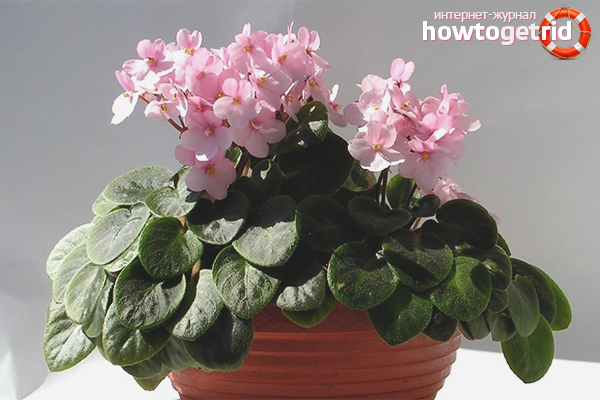
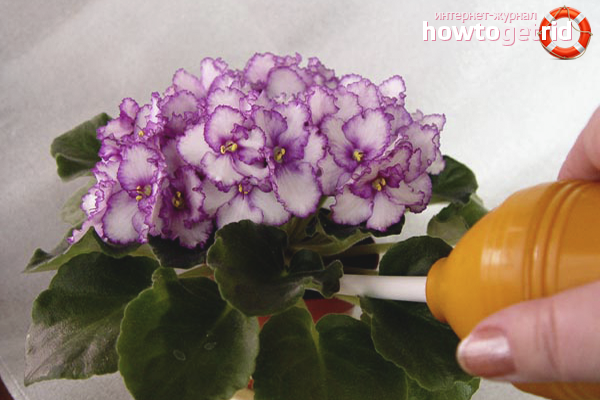
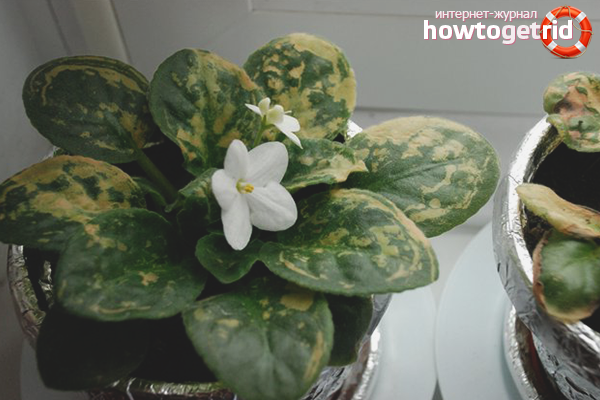



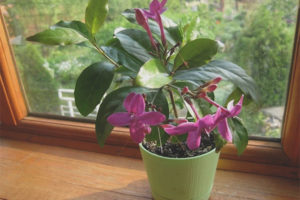


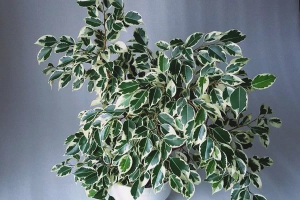

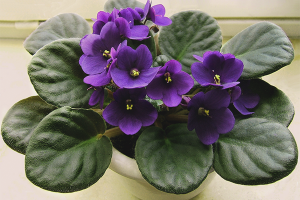
Submit